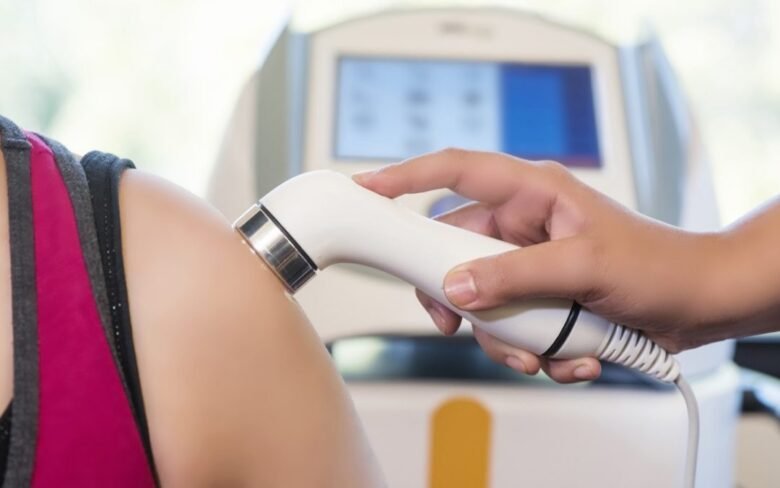It is often said that pain should never be treated lightly. There’s a saying in Latin that roughly translates to “No pain, no gain”. For some people, it is a philosophy they live by, but for others, the experience is more like a burdensome parasite that requires them to seek relief. However, what if there was a method to help manage pain through sound?
This is the introduction of therapeutic ultrasound, which might just change the narrative. This technique is brand new and it’s already provoking a lot of discussion amongst the masses. A lot of people are already voicing scepticism about its overall effectiveness but for chronic pain sufferers or individuals recovering from a serious injury, it can be a ray of hope. Let’s take a closer look at this ground-shaking technology and see its applications.
How Does Therapeutic Ultrasound work?
Therapeutic ultrasound employs the use of sound waves to channel deep into the tissues. This direct heating action of the waves helps the patient relieve discomfort. Helping with blood circulation and facilitating healing, soundwaves travel through the soft tissue, causing inflammation and scar tissue to dissipate. The rotation from the waves prompts the wave’s cellular repair as well, which makes this process that much more effective.
The procedure is non-invasive and usually carried out by qualified specialists. Most of the people undergoing the treatment appreciate the soothing warmth experienced during treatment. Different frequencies can be used depending on the depth of tissue needing treatment. High-frequency ultrasound targets superficial layers, while lower frequencies reach deeper tissues effectively. The capability of this modality to target a variety of conditions with minimal side effects differentiates it in the range of pain management methods. This provides a new perspective that complements the existing methods of treatment without surgical procedures or medication.
Advantages of Ultrasound Therapy:
Therapeutic ultrasound has a wide range of great advantages, which explains its popularity in relieving pain. Perhaps one of its most well-known traits is the enhancement of tissue inflammation. As a result, there could be a decrease in swelling and pain as well.
Another important enhancement is blood circulation. The innocence and warmth of these ultrasound waves could also aid in the circulation of blood to the intended areas or tissues.
After sessions, patients can report improvements in body mobility; this is quite beneficial to patients who have just suffered injuries or gone through a surgical operation since it accelerates the healing process.
Moreover, using therapeutic ultrasound can assist in tissue healing on a cellular level. It also promotes tendon and ligament healing over time by stimulating collagen production.
There are a large number of people who look forward to utilising this technique since it is painless and not intrusive. There is no requirement for any kind of medication or even an operation; therefore, it attracts those who prefer considering alternate means of seeking health care.
Effective Uses of Therapeutic Ultrasound:
Employing therapeutic ultrasound is useful for addressing a myriad of pain issues. It has been useful in treating musculoskeletal-related injuries like sprain and strain, for it is suitable for them. Some athletes use this form of treatment in order to recover rapidly.
Other chronic pain syndromes like tendonitis greatly benefit from ultrasound therapy as well. The use of ultrasound therapy alleviates affected areas by providing healing through gentle vibrations that function to reduce inflammation.
There is also relief for people who are suffering from arthritis as well. There is no need for any medicine to try and ease joint stiffness and enhance mobility since ultrasound is non-punching and therapeutic.
Furthermore, it has been used for soft tissue injuries like ligaments or bursitis. Using ultrasound improves the specific area with increased blood circulation and tissue repair speeds.
Surgical patients will also be able to find comfort from this technique. It helps in both scar tissue remodelling and the treatment of chronic pain related to surgery.
Precautions and Side Effects:
Despite therapeutic ultrasound being much safer, some precautions must still be observed. There has to be a healthcare provider to talk to before one starts this treatment. They are in a good position to offer directions that suit the respective case. Some patients with portable medical devices or skin infections may need to forego such therapy. Pregnant women also need to be careful and ask their physicians for alternatives.
While not common, some side effects may arise. There are patients who, during the surgery, experience mild pain or experience slight blushing, or skin redness after the surgery. Substantial interventions are rarely required, as the vast majority of these symptoms tend to resolve rapidly. After treatment, it is prudent to check for any atypical responses. Regular contact with your healthcare provider will ensure that your concerns will be dealt with efficiently and effectively. Such an approach allows one to take maximum advantage and least risk concerning therapeutic ultrasound.
Comparison with other Pain Relief Methods:
There are some factors related to therapeutic ultrasound that differentiate it from traditional methods when looking at its application or side effects; for instance, the addiction aspect gifted by traditional pain relief medication. Among many alternatives that exist, ultrasound comes in as a better treatment since it has no side effects. The same has been noted with patients, who many times cite a reduction in complications and medication usage.
Massage and other forms of physical therapy may be able to provide some relief but may only be effective in providing relief on a superficial level. Through the use of Therapeutic ultrasound, it is possible to reach deeper tissues within the muscles while also encouraging restorative processes within the cells at the same time. Furthermore, other intervention approaches, such as heat or cold application, may assist with pain control but are limited to short periods. Over time, ultrasound enhances general well-being by promoting circulation and tissue healing.
Although other surgical methods work in severe conditions, they do have complications as well as extended healing times. The likely reason therapeutic ultrasound is typically painless and requires one to avoid physical activity that is straining your muscles for a short period, making it preferable to someone looking for an efficient pain management strategy without having to undergo surgical procedures.
The Future of Therapeutic Ultrasound:
With advancements in technology, the future of therapeutic ultrasound seems to be bright and full of possibilities. Researchers are just scratching the surface when it comes to the applications of this technology. The most popular application is pain management but researchers are looking into its use for inflammation and tissue restoration.
We may soon see ultrasound worked on devices able to provide real-time feedback to distinguishing practitioners, making the working dynamics a lot more interesting and new. This would not only provide patients with tailored treatments unique to their condition but also generic treatments, making the process of tailoring the treatment much quicker. Moreover, the interrelation with digital health hubs may make the procedure a lot easier. Such devices would not be limited to practicing facilities, but patients will be able to use them at home or while travelling.
The studies done on efficacy so far have been on the positive side; we may witness wider use of therapeutic ultrasound technology across different healthcare streams. Collaborations between engineers as well as medical practitioners shall produce useful innovations that target sound waves to work within the limits of a given condition. This all shows that the future is brighter with an evolution in therapeutic ultrasound so that it becomes part of all the ailments in the health systems.
Conclusion:
Its low-frequency vibrations can serve to relieve a host of ailments, and hence therapeutic ultrasound can be regarded as a potential pain management tool. Its unique inbuilt feature of being able to transfer energy, which helps in tissue regeneration, is truly one of a kind. With improved technology, so do the potential roles of therapeutic ultrasound. This may indeed open up new ways to treat long-term diseases and improve rehabilitation processes, irrespective of the various parameters.
With better understanding and more clinical testing being accomplished around this technique, patients are making this approach a part of their wellness routine. Moreover, the rising evidence of beneficial clinical outcomes reinforces the overall trust in its adoption. So, witnessing more creativity and inventiveness to change the perception of pain management would not be shocking here. There is so much precision that life can become for millions of patients when new methodologies like these begin getting adopted.
FAQs:
1. What conditions can therapeutic ultrasound treat?
Therapeutic ultrasound has been shown to be effective in the treatment of a variety of musculoskeletal disorders, which include tendonitis, bursitis, muscle strain, and many others. It is additionally used in physical medicine as a treatment modality to speed up and enhance the inflammatory response.
2. Is therapeutic ultrasound safe?
Surgeries performed on trained professionals are believed to be relatively safe; however, it is strongly recommended that any such procedures are performed only by qualified individuals. Nevertheless, practitioners should refrain from it on grounds of tumours and infections.
3. How long does a session take?
Most of the time, the lapsed duration of a session would range between five and fifteen minutes, depending on the area being treated and the type of condition being treated. It is the sole responsibility of the practicing care professional to make the call of time needed by patients.
4. Are there any side effects associated with therapeutic ultrasound?
Side effects are rare; however, bruising and warmth at the site of treatment are some contemporary side effects. So in most other cases, patients don’t report a high level of discomfort during the treatment.
5. Can I combine therapeutic ultrasound with other treatments?
Oh absolutely, many patients find using therapeutic ultrasound in conjunction with physical therapy exercises or pills more useful for faster recovery and better pain relief.



